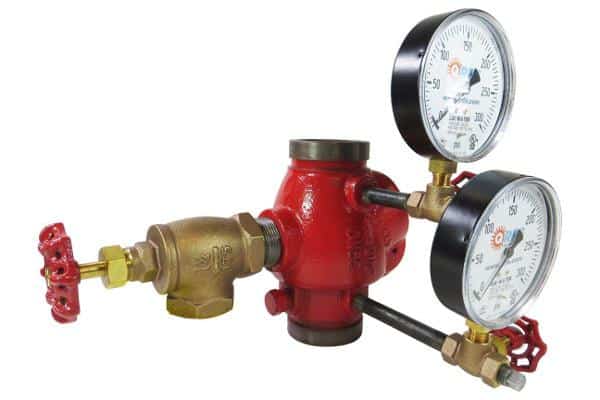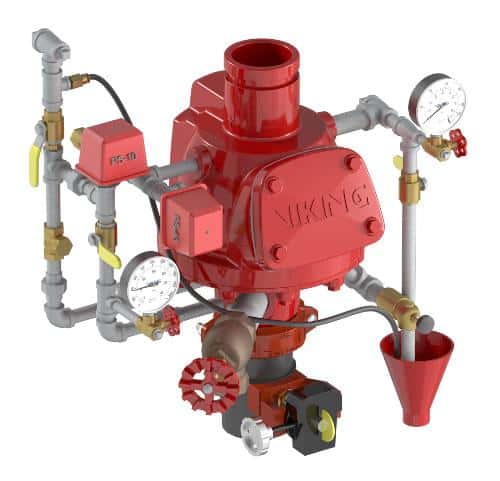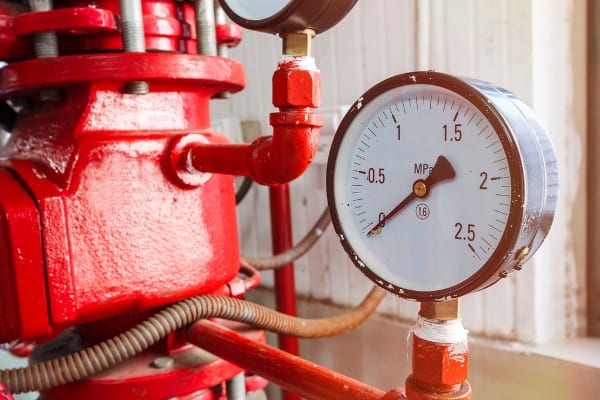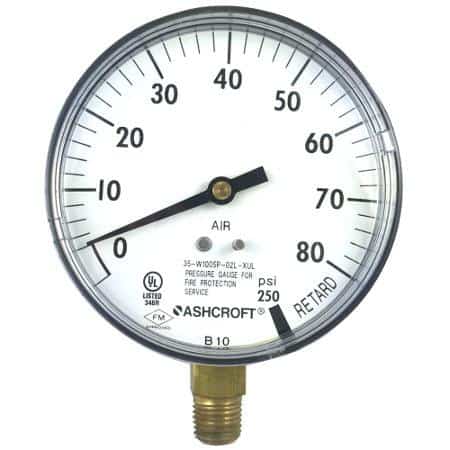Air pressure gauges and water pressure gauges in fire sprinkler systems must be properly placed and kept in working order
Fire sprinkler systems require pressure gauges at check valves, control valves, the main drain, and a host of other locations. And keeping fire sprinkler gauges in working order simplifies inspections and makes spotting serious problems — from a lack of water pressure to a closed valve — much easier. In this article, we’ll look at where these devices are placed in commercial and residential fire sprinkler systems and when they need to be replaced.
If you’ve already decided to buy a new gauge, click here to view our selection of fire sprinkler pressure gauges.
Most wet-pipe, dry-pipe, and other fire sprinkler systems include pressure gauges at critical locations
Fire sprinkler pressure gauges are located in various systems at pressure-reducing valves, the system main drain, and other main drains specified in the National Fire Protection Association’s NFPA 13: Standard for the Installation of Sprinkler Systems. The standard applied to commercial systems, including those in factories, auditoriums, office spaces, and most other public buildings, not the residential occupancies covered by NFPA 13R and NFPA 13D.
From the 2022 edition of NFPA 13
16.13 Gauges.
16.13.1 A pressure gauge with a connection not smaller than 1⁄4 in. (6 mm) shall be installed at the system main drain, at each main drain associated with a floor control valve, and on the inlet and outlet side of each pressure-reducing valve.
Pressure gauges in wet-pipe fire sprinkler systems are required at each system riser check valve and alarm check valve — both of which are essential components.
From the 2022 edition of NFPA 13
8.1 Wet Pipe Systems.
8.1.1 Pressure Gauges.
8.1.1.1 An approved pressure gauge conforming to Section 16.13 shall be installed in each system riser.
8.1.1.2* Pressure gauges shall be installed above and below each alarm check valve or system riser check valve where such devices are present.
8.1.1.2.1 A single pressure gauge shall be permitted to be installed on a manifold below multiple riser check valves or alarm check valves.
8.1.1.2.2 Pressure gauges below check valves required by 16.9.11 and 16.15.2.2(1) shall not be required.
Each check valve monitors water pressure with two pressure gauges: one on the “supply side” of the valve, which offers a view of the air or water pressure between the water supply and the valve, and another on the “system side” of the valve, which displays the pressure between the valve and the system’s sprinklers. Here’s how NFPA 13 explains the exception in section 8.1.1.2.2 (for check valves on individual floors), however:
A pressure gauge is not required on the supply side of individual floor control valve assemblies even if the assembly contains a check valve and a waterflow switch. This requirement is applicable to combined standpipe/sprinkler systems, as illustrated in Figures A.16.15.2.2(a) through (c), as well as other horizontal system riser assemblies on individual floors. Since there are gauges on the standpipe system at the top, an additional gauge on every floor would be redundant. The supply pressure on each floor can be calculated easily by reading the gauge at the top and reducing for elevation.

Pressure gauges in dry-pipe fire sprinkler systems are installed at the dry-pipe valve, air pumps and receivers, some pipes between the dry pipe system and the system’s air supply, as well as at quick-opening devices. The gauges must be approved by the authority having jurisdiction (AHJ).
From the 2022 edition of NFPA 13
8.2* Dry Pipe Systems.
8.2.1 Pressure Gauges. Approved pressure gauges in accordance with Section 16.13 shall be connected as follows:
(1) On the water side and air side of the dry pipe valve
(2) At the air pump supplying the air receiver where one is provided
(3) At the air receiver where one is provided
(4) In each independent pipe from air supply to dry pipe system
(5) At quick-opening devices

Preaction systems and deluge systems require approved gauges at the preaction or deluge valve and at the air supply to those valves.
From the 2022 edition of NFPA 13
8.3 Preaction Systems and Deluge Systems.
8.3.1.3 Pressure Gauges. Approved pressure gauges conforming with Section 16.13 shall be installed as follows:
(1) Above and below preaction valve and below deluge valve
(2) On air supply to preaction and deluge valves
Exposure-fire protection sprinkler systems, which are used to guard a building’s exterior against outdoor fires, those spreading from nearby buildings or wildfires, require a pressure gauge below the control valve.
8.7 Outside Sprinklers for Protection Against Exposure Fires (Exposure Protection Sprinkler Systems).
8.7.7 Gauge Connections. A pressure gauge conforming to Section 16.13 shall be installed immediately below the control valve of each system.
Larger residential buildings require fire sprinkler gauges at selected drains and valves
Some fire sprinkler gauges are mandatory in sprinkler systems serving multifamily residential occupancies, including apartment buildings, hotels, and mixed occupancies with up to four above-ground stories. These gauges are located at the system’s main drain, pressure-reducing valves, and near other critical system components. Low-rise residential systems also require gauges used to monitor system pressure and supply pressure.
Each gauge installed in accordance with NFPA 13R: Standard for the Installation of Sprinkler Systems in Low-Rise Residential Occupancies must be approved for service by the authority having jurisdiction.
From the 2022 edition of NFPA 13R
5.2.15 Gauges.
5.2.15.1 A pressure gauge with a connection not smaller than 1⁄4 in. (6 mm) shall be installed at the system main drain, at each main drain associated with a floor control valve, and on the inlet and outlet side of each pressure-reducing valve.
6.12 Pressure Gauges.
6.12.1 A pressure gauge with shutoff valve shall be provided to indicate pressure of the supply.
6.12.2 A pressure gauge with shutoff valve shall be provided to indicate pressure of the system.
Fire sprinkler gauges are less common in home fire sprinkler systems
A residential fire sprinkler system in a single-family home, duplex, or manufactured home requires fewer to no gauges and less frequent inspection than those in commercial or large residential sprinkler systems.
The vast majority of home fire sprinkler systems installed following NFPA 13D: Standard for the Installation of Sprinkler Systems in One- and Two-Family Dwellings and Manufactured Homes are wet-pipe systems, most of which don’t require pressure gauges in this residential application. However, there are rules mandating gauges in dry-pipe sprinkler systems or wet sprinkler systems that use a pressure tank for their water supply or are standalone systems with pressure-reducing or -regulating valves. These gauges do not need to be listed.
From the 2022 edition of NFPA 13D
7.3 Pressure Gauges.
7.3.1 Where a dry system is installed, a pressure gauge shall be installed to indicate system air pressure.
7.3.2 Where a pressure tank is used for the water supply, a pressure gauge shall be installed to indicate tank pressure.
7.3.3 Where a pressure-reducing or pressure-regulating valve is installed on a stand-alone system, a pressure gauge shall be installed downstream of the device.
Regular inspection and periodic replacement or recalibration of inaccurate fire sprinkler gauges are required for most systems
Most fire sprinkler gauges — excluding those found in home fire sprinkler systems installed following NFPA 13D — must be replaced or reconditioned as soon as possible after damage, dysfunction, or defacement is observed.
Although fire sprinkler systems remain operational when a gauge is out of order, well-kept pressure gauges provide inspectors, fire service officials, and facilities managers a means to get an instant read on the sprinkler system’s pressure and identify more pressing problems, such as a closed valve. At a minimum, issues with gauges should be identified and corrected during required monthly and quarterly inspections outlined in NFPA 25: Standard for the Inspection, Testing, and Maintenance of Water-Based Fire Protection Systems.
To learn more about required gauge inspections on NFPA 25-maintained fire sprinkler systems, read QRFS’ overview of inspections for fire sprinkler system signs, gauges, and alarms.
Chapter 3 of NFPA 25 categorizes problems as impairments, where an inoperable component may cause the fire sprinkler system to fail during a fire, or deficiencies, which are less severe than impairments but still may impact the system’s performance (critical) or otherwise require correction (non-critical).
Very few problems with pressure gauges could cause a fire sprinkler system to fail to function during a fire. However, these issues may be a symptom of a larger problem that, if unaddressed, may damage critical components or mean total failure.
Check out our in-depth look at classifying deficiencies and impairments in fire sprinkler systems.
From the 2023 edition of NFPA 25
4.1.5.1* The property owner or designated representative shall correct or repair deficiencies or impairments.
A.4.1.5.1 System deficiencies not explained by normal wear and tear, such as hydraulic shock or internal pipe corrosion, can often be indicators of system problems and should be investigated and evaluated by qualified personnel or engineer. Failure to address these issues could lead to catastrophic failure. Examples of deficiencies caused by issues beyond normal wear and tear are as follows:
(1) Pressure gauge deficiencies as follows:
(a) Gauge not returning to zero
(b) Gauge off scale
(c) Gauge with bent needle
NFPA 25 requires different inspections depending on the type of system:
For wet systems:
13.2.4.1.1* Gauges shall be inspected monthly to verify that the gauges are operable and not physically damaged.
13.2.4.1.2 Gauges monitoring water pressure shall be inspected quarterly to verify that normal water supply pressure is being maintained.
For dry or preaction systems:
13.2.4.1.3 Gauges monitoring air or nitrogen pressure shall be inspected monthly to verify that normal air or nitrogen pressure are being maintained.
13.2.4.1.3.1 The gauge on the quick-opening device, if provided, shall indicate the same pressure as the gauge on the system side of the dry pipe valve.
13.2.4.1.3.2 Where air pressure supervision is connected to a constantly attended location, gauges shall be inspected quarterly.
13.2.4.1.4* For dry pipe or preaction systems protecting freezers with an air pressure gauge(s) on the air line(s) between the compressor and the dry pipe or preaction valve, the air pressure gauge near the compressor shall be compared monthly to the pressure gauge above the dry pipe or preaction valve.
NFPA 25 also mandates gauge replacement or recalibration when accuracy or longevity is in question.
13.2.4.2* Gauges shall be replaced every 5 years or tested every 5 years by comparison with a calibrated gauge.
13.2.4.3 Gauges not accurate to within 3 percent of the full scale shall be recalibrated or replaced.
In a gauge designed to display readings between 0 PSI and 300 PSI, the full scale would be 300 minus 0, or 300. Section 13.2.7.3 requires that such a gauge display readings with no more than a 3% error in either direction or, in this case, 300 x 0.03 = 9 PSI.
This error can be resolved — and a good gauge kept in service — by having the gauge calibrated at a professional calibration laboratory. But many people simply opt to replace inaccuarate or old gauges, as it’s simpler and new ones aren’t expensive.
Fire sprinkler gauge replacement is not required in residential systems built to NFPA 13D standards
While fire sprinkler systems in larger buildings require periodic inspection at prescribed intervals, inspections of fire sprinkler systems in single-family homes, duplexes, and manufactured homes are far less complicated. Annual inspections of select pressure gauges, if they are present, are recommended but not required by NFPA 13D. Replacement of dysfunctional fire sprinkler gauges — as a result of issues found during inspections, when a gauge is inaccurate, or when a gauge is more than five years old — is not explicitly required. But it’s a very good idea to fix any issue that’s found to keep the system working and monitored correctly.
From the 2022 edition of NFPA 13D
12.2* Inspections and Tests. The sprinkler system shall be inspected and tested periodically to make sure the system is in good working condition.
A.12.2 The building owner or manager should understand the sprinkler system operation and conduct periodic inspections and tests to make sure that the system is in good working condition. A recommended inspection and testing program includes the following: …
(6) Annually, fully open the test connection downstream of any pressure-reducing or pressure-regulating valve, and make sure that the pressure gauge reads a reasonable value.
What kind of replacement fire sprinkler gauge do I need?
The installation rules in NFPA 13 or NFPA 13R, including the valve and system-specific standards detailed above, must be followed when replacing a defective or inoperable air or water pressure gauge in a large residential or commercial fire sprinkler system.
From the 2022 edition of NFPA 13
16.13.1 A pressure gauge with a connection not smaller than 1⁄4 in. (6 mm) shall be installed at the system main drain, at each main drain associated with a floor control valve, and on the inlet and outlet side of each pressure-reducing valve.
16.13.2 Each gauge connection shall be equipped with a shutoff valve and provisions for draining.
16.13.3 The required pressure gauges shall be approved and shall have a maximum limit not less than twice the normal system working pressure at the point where installed.
16.13.4 Gauges shall be installed to permit removal and shall be located where they will not be subject to freezing.
Each gauge complies with these standards, is UL and FM-listed (even when it’s not required), includes a 1/4″ (6.35 mm) connection, and displays accurate readings in accordance with NFPA 25. QRFS’ product line includes equipment manufactured by Ashcroft, a Connecticut-based maker of precision fire sprinkler gauges.
If you have any questions about commercial or residential fire sprinkler gauges or need help selecting them, give us a call at 888.361.6662, comment below, or email support@qrfs.com.
This blog was originally posted at QRFS.com/blog. If this article helped you, check us out at Facebook.com/QuickResponseFireSupply or Twitter @QuickResponseFS.



